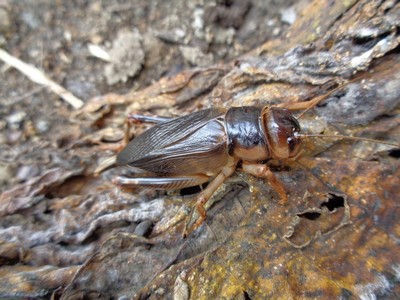WHAT ARE CRICKETS?
 With over 900 species, crickets are jumping insects that can be found worldwide and are well known for their musical chirping. They have very powerful hind legs for jumping, two pairs of wings, flat bodies, and very long antennae. Their colors vary from brown to shiny black. As adults, their size can range anywhere from 3 to 50mm (0.12 to 2 inches). They generally breed and live outdoors and like to invade houses and buildings in search of food, water, and shelter. They are often found in crawl spaces, cellars, and basements. Occasionally they’ll wander up into the living area of the home where their jumping is quick to startle an unaware person. Camel Crickets may also invade homes from wood piles and other areas outside. The natural habitat of a cricket is a wooded area or a field. Around buildings, they will mainly be found living among heavy vegetation, tall weeds, in piles of lumber, firewood, and under various items. They feed on the stems and seeds of different plants like grass, corn, barley, vegetables, and fruits.
With over 900 species, crickets are jumping insects that can be found worldwide and are well known for their musical chirping. They have very powerful hind legs for jumping, two pairs of wings, flat bodies, and very long antennae. Their colors vary from brown to shiny black. As adults, their size can range anywhere from 3 to 50mm (0.12 to 2 inches). They generally breed and live outdoors and like to invade houses and buildings in search of food, water, and shelter. They are often found in crawl spaces, cellars, and basements. Occasionally they’ll wander up into the living area of the home where their jumping is quick to startle an unaware person. Camel Crickets may also invade homes from wood piles and other areas outside. The natural habitat of a cricket is a wooded area or a field. Around buildings, they will mainly be found living among heavy vegetation, tall weeds, in piles of lumber, firewood, and under various items. They feed on the stems and seeds of different plants like grass, corn, barley, vegetables, and fruits.
ARE CRICKETS DANGEROUS?
Although crickets do have the ability to bite, they rarely do so and are in no need of great concern as they are not dangerous to a person’s health or safety. Crickets can be annoying because of their tendency to infest homes and businesses in large numbers, and they are oftentimes difficult to control and eliminate. Their nighttime concerts can be extremely annoying as well as they keep you awake at night. While they are not dangerous, they can cause damage once inside a building. Crickets are known to feed on fabrics like wool, silk, cotton, linen, and fur. They especially like fabrics that have been soiled by perspiration or food. Large numbers of crickets can damage various fabric items along with clothing. Camel Crickets will occasionally feed on paper, but they don’t feed on fabrics. While crickets hold no threat to you, they can cause some damage within your home or business.
WHY DO I HAVE A CRICKET PROBLEM?
Bright lights on buildings and homes attract crickets. This also includes small lights illuminating the garden. Crickets can be found throughout most of the year in the warm months but are known to be a heavier nuisance in the late summer to fall rage. Just like with other pests crickets can fit in through cracks and crevices in the foundation, bad thresholds on doors, or bad seals on windows.
HOW TO GET RID OF A CRICKET PROBLEM?
In order to get rid of crickets one should start with eliminating the harborage areas adjacent to the building as much as possible. Finding any cracks and crevices in the foundation is also highly recommended. Our Code Green Unlimited Service offers coverage for crickets. Give us a call today.
F.A.Q.
Q: What do crickets eat?
Q: How do I get rid of crickets once they are in my home?
Q: How do I get rid of the crickets right outside my window at night?
Areas We Service
- Chalco, NE
- Boys Town, NE
- Green Meadows, NE
- Bellevue, NE
- Springfield, NE
- Bennington, NE
- Offutt Air Base, NE
- Lincoln, NE
- Waverly, NE
- Elkhorn, NE
- Waterloo, NE
- Gretna, NE

